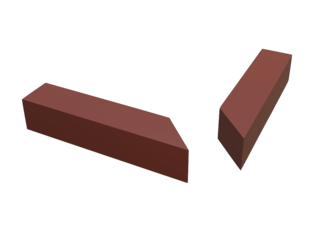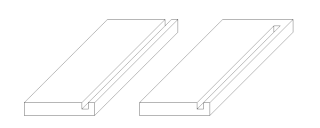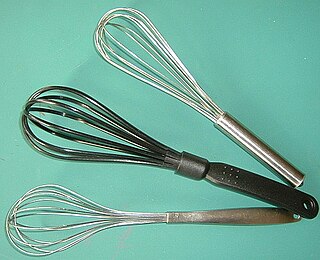
Tongue and groove is a method of fitting similar objects together, edge to edge, used mainly with wood, in flooring, parquetry, panelling, and similar constructions. Tongue and groove joints allow two flat pieces to be joined strongly together to make a single flat surface. Before plywood became common, tongue and groove boards were also used for sheathing buildings and to construct concrete formwork.

A mortiseand tenon joint connects two pieces of wood or other material. Woodworkers around the world have used it for thousands of years to join pieces of wood, mainly when the adjoining pieces connect at right angles.

In woodworking, a rip-cut is a type of cut that severs or divides a piece of wood parallel to the grain. The other typical type of cut is a cross-cut, a cut perpendicular to the grain. Unlike cross-cutting, which shears the wood fibers, a rip saw works more like a series of chisels, lifting off small splinters of wood. The nature of the wood grain requires the shape of the saw teeth to be different, thus the need for both rip saws and crosscut saws; however, some circular saw blades are combination blades and can make both types of cuts. A rip cut is the fundamental type of cut made at a sawmill.

A mandoline or mandolin, is a culinary utensil used for slicing and for cutting juliennes; with suitable attachments, it can make crinkle-cuts.

The shoulder plane is a plane tool with a blade flush with the edges of the plane, allowing trimming right up to the edge of a workpiece. Like a rebate plane, the shoulder plane's blade extends, therefore cuts, to the full width of the tool. The shoulder plane is used to trim the shoulders and faces of tenons. It is used when it is necessary to trim right into the concave corner where two surfaces of the same piece of wood meet perpendicularly. It is also commonly used to clean up dadoes (housings) and tenons for joinery.

A hand plane is a tool for shaping wood using muscle power to force the cutting blade over the wood surface. Some rotary power planers are motorized power tools used for the same types of larger tasks, but are unsuitable for fine-scale planing, where a miniature hand plane is used.

A radial arm saw is a cutting machine consisting of a circular saw mounted on a sliding horizontal arm. Invented by Raymond DeWalt in 1922, the radial arm saw was the primary tool used for cutting long pieces of stock to length until the introduction of the power miter saw in the 1970s.
Square is slang for a person who is conventional and old-fashioned, similar to a fuddy-duddy. This sense of the word "square" originated with the American jazz community in the 1940s in reference to people out of touch with musical trends. Older senses of the term square, referring positively to someone or something honest and upstanding, date back to the 16th century.

A mitre joint is a joint made by cutting each of two parts to be joined, across the main surface, usually at a 45° angle, to form a corner, usually to form a 90° angle, though it can comprise any angle greater than 0 degrees. It is called beveling when the angled cut is done on the side, although the resulting joint is still a mitre joint.

Cytherean is an adjective literally meaning of Cythera. Cythera is a small Greek island, southeast of the Peloponnesus, and a legendary birthplace of the goddess Aphrodite (Venus). The word Cytherean was first applied to the goddess and later, due to word taboo, to the planet Venus that had been named after the goddess.

The rebate plane or rabbet plane is a hand plane designed for cutting rebates/rabbets in wood. It's a simple tool used in many Western countries with hundreds of years of history. It was in use in England at least as early as the 11th century.

A jointer or in some configurations, a jointer-planer is a woodworking machine used to produce a flat surface along a board's length. As a jointer, the machine operates on the narrow edge of boards, preparing them for use as butt joint or gluing into panels. A planer-jointer setup has the width that enables smoothing ('surface planing') and leveling the faces (widths) of boards small enough to fit the tables.

A dado, housing (UK) or trench (Europe) is a slot or trench cut into the surface of a piece of machinable material, usually wood. When viewed in cross-section, a dado has three sides. A dado is cut across, or perpendicular to, the grain and is thus differentiated from a groove which is cut with, or parallel to the grain. Dados are often used to affix shelves to cabinetry bodies. Similar to the dado, see rabbet (rebate).

In joinery, a groove is a slot or trench cut into a member which runs parallel to the grain. A groove is thus differentiated from a dado, which runs across the grain.
Hylopathism, in philosophy, is the belief that some or all matter is sentient or that properties of matter in general give rise to subjective experience. It is opposed to the assertion that consciousness results exclusively from properties of specific types of matter, e.g. brain tissue.

A halved joint is a woodworking joint in which the two members are joined by removing material from each at the point of intersection so that they overlap. The halved joint is differentiated from the lap joint in that the members are joined on edge, rather than on flat.

A bridle joint is a woodworking joint, similar to a mortise and tenon, in that a tenon is cut on the end of one member and a mortise is cut into the other to accept it. The distinguishing feature is that the tenon and the mortise are cut to the full width of the tenon member.
This glossary of woodworking lists a number of specialized terms and concepts used in woodworking, carpentry, and related disciplines.

42355 Typhon (; provisional designation 2002 CR46) is a scattered disc object that was discovered on February 5, 2002, by the NEAT program. It measures 162±7 km in diameter, and is named after Typhon, a monster in Greek mythology.

A whisk is a cooking utensil which can be used to blend ingredients smooth or to incorporate air into a mixture, in a process known as whisking or whipping. Most whisks consist of a long, narrow handle with a series of wire loops joined at the end. The loops can have different shapes depending on a whisk's intended functions. The wires are usually metal, but some are plastic for use with nonstick cookware. Whisks are also made from bamboo.

















